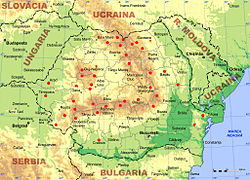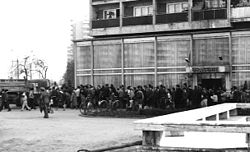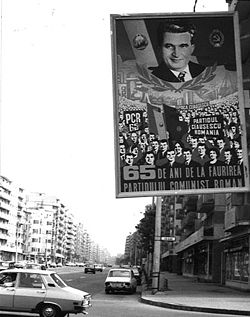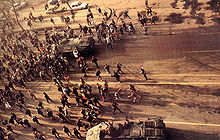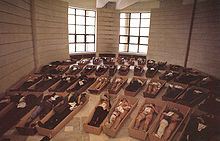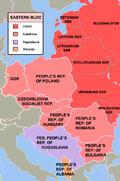- Communist Romania
-
Romanian People's Republic/Socialist Republic of Romania
Republica Populară Romînă/Republica Socialistă România¹Satellite state of the Soviet Union ← 
1947–1989  →
→

Flag Coat of arms Anthem
Zdrobite cătuşe (1947–1953)
Te slăvim Românie (1953–1977)
Trei Culori (1977–1989)
Capital Bucharest Language(s) Romanian Government Socialist republic, Single-party communist state Head of State - 1947–1952 Constantin Parhon - 1952–1958 Petru Groza - 1958–1961 Ion Gheorghe Maurer - 1961–1965 Gheorghe Gheorghiu-Dej - 1965–1967 Chivu Stoica - 1967–1989 Nicolae Ceauşescu Legislature Great National Assembly Historical era Cold War - Monarchy abolished 30 December 1947 - Fall of Ceauşescu 22 December 1989 Area - 1987 238,391 km2 (92,043 sq mi) Population - 1987 est. 23,102,000 Density 96.9 /km2 (251 /sq mi) Currency Romanian Leu Calling code +40 ¹ Until 1965 the official name was Republica Populară Romînă (People's Republic of Romania).
The administrative divisions of the country were judeţe from 1947 to 1950, rayons from 1950 to 1968 and judeţe from 1968 to 1989.Communist Romania was the period in Romanian history (1947–1989) when that country was a Soviet-aligned communist state in the Eastern Bloc, with the dominant role of Romanian Communist Party enshrined in its successive constitutions. Officially, the country was called the Romanian People's Republic (Romanian: Republica Populară Romînă; RPR) from 1947 to 1965, and the Socialist Republic of Romania (Republica Socialistă România; RSR) from 1965 to 1989.
A pro-Soviet government was installed on 6 March 1945. After World War II, the Soviet Union pressed for inclusion of the previously outlawed Communist Party in the post-war government of former Axis Romania, while non-communist political leaders were steadily eliminated from political life. King Michael abdicated under pressure in December 1947 and went into exile, and the Romanian People's Republic was declared.
During the early years, Romania's scarce resources after World War II were drained by the "SovRom" agreements, mixed Soviet-Romanian tax-exempt companies established in the aftermath of World War II which allowed the Soviets to control Romania's major sources of income, in addition to the[1] war reparations paid to the USSR. A large number of people were executed or died in custody; while judicial executions from 1945 to 1964 numbered 137,[2] deaths in custody are estimated in the tens[3] or hundreds of thousands.[4][5] Many more were imprisoned for political, economical or other reasons. There were a large number of abuses, deaths and incidents of torture against a large range of people.
In the 1950s, Romania's communist government began to assert some independence from the Soviet Union. One example of this new independence is when Romania convinced the Soviet Union to withdraw all Soviet troops from Romania by 1958. Nicolae Ceauşescu became head of the Communist Party in 1965 and head of state in 1967, assuming the newly-established role of President of Romania in 1974. Ceauşescu's denunciation of the 1968 Soviet invasion of Czechoslovakia and a brief relaxation in internal repression helped give him a positive image both at home and in the West. Rapid economic growth fueled by foreign credits gradually gave way to austerity and political repression that led to the fall of the authoritarian government in December 1989.
Contents
Rise of the Communists
Main article: Soviet occupation of Romania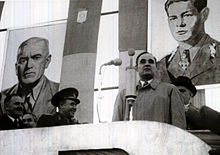 Gheorghe Gheorghiu-Dej speaking at a workers' rally in Nation Square, Bucharest after the 1946 elections.
Gheorghe Gheorghiu-Dej speaking at a workers' rally in Nation Square, Bucharest after the 1946 elections.
When King Michael, supported by the main political parties, overthrew Ion Antonescu in August 1944, breaking Romania away from the Axis and bringing it over to the Allied side, Michael could do nothing to erase the memory of his country's recent active participation in the German invasion of the Soviet Union. Romanian forces fought under Soviet command, driving through Northern Transylvania into Hungary proper, and on into Czechoslovakia, Austria and Germany. However, the Soviets treated Romania as conquered territory,[6] and Soviet troops remained in the country as occupying forces under the pretext that Romanian authorities could not guarantee the security and stability of Northern Transylvania.
The Yalta Conference had granted the Soviet Union a predominant interest in Romania, the Paris Peace Treaties failed to acknowledge Romania as a co-belligerent, and the Red Army was sitting on Romanian soil. The Communists played only a minor role in Michael's wartime government, headed by General Nicolae Rădescu, but this changed in March 1945, when Dr. Petru Groza of the Ploughmen's Front, a party closely associated with the Communists, became prime minister. Although his government was broad, including members of most major prewar parties except the Iron Guard, the Communists held the key ministries.
The King was not happy with the direction of this government, but when he attempted to force Groza's resignation by refusing to sign any legislation (a move known as "the royal strike"), Groza simply chose to enact laws without bothering to obtain Michael's signature. On 8 November 1945, King Michael's name day, an anti-communist demonstration in front of the Royal Palace in Bucharest was met with force, resulting in dozens of killed and wounded; Soviet officers restrained Romanian soldiers and police from firing on civilians, and Soviet troops restored order.[7]
Despite the King's disapproval, the first Groza government brought land reform and women's suffrage. However, it also brought the beginnings of Soviet domination of Romania. In the elections of 19 November 1946, Communists claimed 80% of the votes in the elections. After forming government, the Communists worked to eliminate the role of the centrist parties; notably, the National Peasant Party was accused of espionage after it became clear in 1947 that their leaders were meeting secretly with United States officials. A show trial of their leadership was then arranged, and they were put in jail. Other parties were forced to "merge" with the Communists.
In 1946–7, hundreds of participants in the pro-Axis government were executed as war criminals, primarily for their involvement in the Holocaust and for attacking the Soviet Union. Antonescu himself was executed 1 June 1946. By 1948, most non-Communist politicians were either executed, in exile or in prison.
Romania remained the only monarchy in the Eastern Bloc by 1947. On 30 December of that year, the Communists forced King Michael to abdicate. The Communists declared a People's Republic, formalized with the constitution of 13 April 1948.
The new constitution forbade and punished any association which had "fascist or anti-democratic nature". It also granted the freedom of press, speech and assembly for the working class. In the face of wide-scale killings, imprisonments and harassment of local peasants during forced collectivization, entire private property nationalization and political oppressiveness, the Constitution of 1948 and the subsequent basic texts were never respected by governments or the new judges appointed during dictatorship.
The Communist government also disbanded the Romanian Greek-Catholic Uniate Church, declaring its merger with the Romanian Orthodox Church.
Early years of the communist state
 1949 stamp celebrating "Romanian-Soviet friendship"
1949 stamp celebrating "Romanian-Soviet friendship"
The early years of Communist rule in Romania were marked by repeated changes of course and by numerous arrests and imprisonments as factions contended for dominance. The country's resources were also drained by the Soviet's SovRom agreements, which facilitated shipping of Romanian goods to the Soviet Union at nominal prices. In all ministries there were Soviet "advisers" who reported directly to Moscow and held the real decision-making powers. All walks of life were infiltrated by agents and informers of the secret police.
In 1948 the earlier agrarian reform was reversed, replaced by a move toward collective farming. This resulted in forced collectivization, since wealthier peasants generally did not want to give up their land voluntarily, and had to be "convinced" by beatings, intimidation, arrests and deportations.
On 11 June 1948, all banks and large businesses were nationalized.
In the Communist leadership, there appear to have been three important factions, all of them Stalinist, differentiated more by their respective personal histories than by any deep political or philosophical differences:
- The "Muscovites", notably Ana Pauker and Vasile Luca, had spent the war in Moscow.
- The "Prison Communists", notably Gheorghe Gheorghiu-Dej, had been imprisoned during the war.
- The somewhat less firmly Stalinist "Secretariat Communists", notably Lucreţiu Pătrăşcanu had made it through the Antonescu years by hiding within Romania and had participated in the broad governments immediately after King Michael's 1944 coup.
Ultimately, with Joseph Stalin's backing, and probably due in part to the anti-Semitic[dubious ] policies of late Stalinism (Pauker was Jewish), Gheorghiu-Dej and the "Prison Communists" won out. Pauker was purged from the party (along with 192,000 other party members); Pătrăşcanu was executed after a show trial.
The Gheorghiu-Dej era
Gheorghiu-Dej, a firm Stalinist, was not pleased with the reforms in Nikita Khrushchev's Soviet Union after Stalin's death in 1953. He also blanched at Comecon's goal of turning Romania into the "breadbasket" of the East Bloc, pursuing a program of the development of heavy industry. He also closed Romania's largest labor camps, abandoned the Danube–Black Sea Canal project, halted rationing and hiked workers' wages. Further, there was continuing resentment that historically Romanian lands remained part of the Soviet Union as the Moldavian SSR. These factors combined to put Romania under Gheorghiu-Dej on a relatively independent and nationalist route.
Gheorghiu-Dej identified with Stalinism, and the more liberal Soviet government threatened to undermine his authority. In an effort to reinforce his position, Gheorghiu-Dej pledged cooperation with any state, regardless of political-economic system, as long as it recognized international equality and did not interfere in other nations' domestic affairs. This policy led to a tightening of Romania's bonds with China, which also advocated national self-determination.
Gheorghiu-Dej resigned as the party's general secretary in 1954 but retained the premiership; a four-member collective secretariat, including Nicolae Ceauşescu, controlled the party for a year before Gheorghiu-Dej again took up the reins. Despite its new policy of international cooperation, Romania joined the Warsaw Treaty Organization (Warsaw Pact) in 1955, which entailed subordinating and integrating a portion of its military into the Soviet military machine. Romania later refused to allow Warsaw Pact maneuvers on its soil and limited its participation in military maneuvers elsewhere within the alliance.
In 1956, the Soviet premier, Nikita Khrushchev, denounced Stalin in a secret speech before the Twentieth Congress of the Communist Party of the Soviet Union (CPSU). Gheorghiu-Dej and the leadership of the Romanian Workers' Party (Partidul Muncitoresc Român, PMR) were fully braced to weather de-Stalinization. Gheorghiu-Dej made Pauker, Luca and Georgescu scapegoats for the Romanian communists' past excesses and claimed that the Romanian party had purged its Stalinist elements even before Stalin had died.
In October 1956, Poland's communist leaders refused to succumb to Soviet military threats to intervene in domestic political affairs and install a more obedient politburo. A few weeks later, the Communist Party in Hungary virtually disintegrated during a popular revolution. Poland's defiance and Hungary's popular uprising inspired Romanian students and workers to demonstrate in university and industrial towns calling for liberty, better living conditions, and an end to Soviet domination. Under the pretext that the Hungarian uprising might incite his nation's own revolt, Gheorghiu-Dej took radical measures which meant persecutions and jailing of various "suspects", especially people of Hungarian origin. He also advocated swift Soviet intervention, and the Soviet Union reinforced its military presence in Romania, particularly along the Hungarian border. Although Romania's unrest proved fragmentary and controllable, Hungary's was not, so in November Moscow mounted a bloody invasion of Hungary. Romania offered to take part in the military intervention in Hungary in 1956, but Nikita Khruschev rejected the proposal.
After the Revolution of 1956, Gheorghiu-Dej worked closely with Hungary's new leader, János Kádár, who was installed by the Soviet Union. Romania took Hungary's former premier (leader of the 1956 revolution) Imre Nagy into custody. He was jailed at Snagov, north of Bucharest. After a series of interrogations by Soviets and Romanian authorities, Nagy was returned to Budapest for trial and execution.
In Transylvania, the Romanian authorities merged Hungarian and Romanian universities at Cluj, putting an end to the Hungarian Bólyai University, and also worked on gradually eliminating Hungarian education in middle schools by transforming them into Romanian ones.
Under the pretext of calling numerous ethnic Hungarians "irredentists" who were "dangers to Romania's territorial integrity", the communist government led by Gheorghiu-Dej jailed a large number of Hungarians, as well as executing some. During his 2007 visit, Hungarian president László Sólyom asked for the rehabilitation of the politically persecuted Hungarians, among whom were numerous poets, writers, university teachers. The Hungarian president also mentioned that 20 Hungarians were executed and that over 40 thousand years of jail were given in total to ethnic Hungarians. The request for rehabilitation of the politically persecuted Hungarians was not taken into consideration by the Romanian side.[citation needed]
Gheorghiu-Dej spread fears about Hungary wanting to take over Transylvania. He took a two-pronged approach to the problem, arresting the leaders of the Hungarian People's Alliance, but, under Soviet pressure, establishing a nominally autonomous Hungarian region in the Székely land.
Romania's government also took measures to allay domestic discontent by reducing investments in heavy industry, boosting output of consumer goods, decentralizing economic management, hiking wages and incentives, and instituting elements of worker management. The authorities eliminated compulsory deliveries for private farmers but reaccelerated the collectivization program in the mid-1950s, albeit less brutally than earlier. The government declared collectivization complete in 1962, when collective and state farms controlled 77% of the arable land.
Despite Gheorghiu-Dej's claim that he had purged the Romanian party of Stalinists, he remained susceptible to attack for his obvious complicity in the party's activities from 1944 to 1953. At a plenary PMR meeting in March 1956, Miron Constantinescu and Iosif Chişinevschi, both Politburo members and deputy premiers, criticized Gheorghiu-Dej. Constantinescu, who advocated a Khrushchev-style liberalization, posed a particular threat to Gheorghiu-Dej because he enjoyed good connections with the Moscow leadership. The PMR purged Constantinescu and Chişinevschi in 1957, denouncing both as Stalinists and charging them with complicity with Pauker. Afterwards, Gheorghiu-Dej faced no serious challenge to his leadership. Ceauşescu replaced Constantinescu as head of PMR cadres.
Some Romanian Jews initially favored Communism, in reaction to the anti-Semitism of the Fascists during World War II. However, by the 1950s, most were disappointed with the increasing discrimination of the Party and the limitations for emigration to Israel.
Persecution, the labor camp system and anti-communist resistance
Main articles: Romanian anti-communist resistance movement, Bărăgan deportations, and Piteşti prisonHarsh persecutions of any real or imagined enemies of the Communist government started with the Soviet occupation in 1945. The Soviet army behaved as an occupation force (although theoretically it was an ally against Nazi Germany), and could arrest virtually anyone at will, for perceived "fascist" or "anti-Soviet" activities.
Shortly after Soviet occupation, ethnic Germans (who were Romanian citizens and had been living as a community in Romania for 800 years) were deported to the Donbas coal mines (see Flight and expulsion of Germans from Romania during and after World War II). Despite the King's protest, who pointed out that this was against international law, an estimated 70,000 men and women were forced to leave their homes, starting in January 1945, before the war had even ended. They were loaded in cattle cars and put to work in the Soviet mines for up to ten years as "reparations", where about one in five died from disease, accidents and malnutrition.
Once the Communist government became more entrenched, the number of arrests increased. All strata of society were involved, but particularly targeted were the pre-war elites, such as intellectuals, clerics, teachers, former politicians (even if they had left-leaning views) and anybody who could potentially form the nucleus of anti-Communist resistance.
The existing prisons were filled with political prisoners, and a new system of forced labor camps and prisons was created, modeled after the Soviet Gulag. A futile project to dig the Danube-Black Sea Canal served as a pretext for the erection of several labor camps, where numerous people died. Some of the most notorious prisons included Sighet, Gherla, Piteşti and Aiud, and forced labor camps were set up at lead mines and in the Danube Delta.
The prison in Piteşti was the epicenter of a particularly vicious communist "experiment" during this era. It involved both psychological and physical torture, resulting in the total breakdown of the individual. The ultimate aim was to force prisoners to "confess" to imaginary crimes or "denounce" themselves and others, therefore prolonging their prison sentences. This "experiment" resulted in numerous suicides inside the prison and was ultimately stopped.
The Stalinist measures of the Communist government included deportation of peasants from the Banat (south-east Transylvania, at the border with Yugoslavia), started on 18 June 1951. About 45,000 people were given two hours to collect their belongings, loaded up in cattle cars under armed guard, and were then forcibly "resettled" in barren spots on the eastern plains (Bărăgan). This was meant as an intimidation tactic to force the remaining peasants to join collective farms. Most deportees lived in the Bărăgan for 5 years (until 1956), but some remained there permanently.
Anti-communist resistance also had an organized form, and many people opposing the government took up arms and formed partisan groups, comprising 10–40 people. There were attacks on police posts and sabotage. Some of the famous partisans were Elisabeta Rizea from Nucşoara and Gheorghe Arsenescu. Despite a large number of secret police (Securitate) and army troops massed against them, armed resistance in the mountains continued until the early 1960s, and one of the best known partisan leaders was not captured until 1974.
Another form of anti-communist resistance, non-violent this time, was the student movement of 1956. In reaction to the anti-communist revolt in Hungary, echoes were felt all over the Eastern bloc. Protests took place in some university centers resulting in numerous arrests and expulsions. The most organized student movement was in Timişoara, where 3000 were arrested.[8] In Bucharest and Cluj, organized groups were set up which tried to make common cause with the anti-communist movement in Hungary and coordinate activity. The authorities' reaction was immediate – students were arrested or suspended from their courses, some teachers were dismissed, and new associations were set up to supervise student activities.
The Ceauşescu government
Gheorghiu-Dej died in 1965 in unclear circumstances (his death apparently occurred when he was in Moscow for medical treatment) and, after the inevitable power struggle, was succeeded by the previously obscure Nicolae Ceauşescu. Where Gheorghiu-Dej had hewed to a Stalinist line while the Soviet Union was in a reformist period, Ceauşescu initially appeared to be a reformist, precisely as the Soviet Union was headed into its neo-Stalinist[citation needed] era under Leonid Brezhnev.
Gheorghiu-Dej exploited the Soviet–Chinese dispute in his last two years and began to oppose the hegemony of the Soviet Union from a Romanian national position. Ceauşescu, supported by a part of the former collaborators of Gheorghiu-Dej, like Maurer, continued this line which was naturally very popular in the country. The relations with Western countries, but also with many other states, began to be strengthened in what seemed to be the national interest of Romania. The forced Soviet (mostly Russian) cultural influence in the country which characterized the fifties was stopped.
The first years
In 1965, following the example of Czechoslovakia, the name of the country was changed to Republica Socialistă România (RSR, The Socialist Republic of Romania), and PMR's old name was restored, and it once again became Partidul Communist Român (PCR, The Romanian Communist Party).
In his early years in power, Ceauşescu was genuinely popular, both at home and abroad. Agricultural goods were abundant, consumer goods began to reappear, there was a cultural thaw, and, what was important abroad, he spoke out against the 1968 Soviet invasion of Czechoslovakia. While his reputation at home soon paled, he continued to have uncommonly good relations with Western governments and with international capitalist institutions such as the International Monetary Fund and World Bank because of his independent political line. Romania under Ceauşescu maintained and sometimes improved diplomatic and other relations with, among others, West Germany, Israel, China, Albania, and Pinochet's Chile, all for various reasons not on good terms with Moscow.
Human rights issues
Concerns over aging populace resulted in reproductive freedoms being severely restricted. Wishing to increase the birth rate, in 1966, Ceauşescu promulgated the decree 770 restricting abortion and contraception: only women over the age of 45 who had at least four children were eligible for either; in 1989, the number was increased to five children.[9] Mandatory gynecological revisions and penalizations against unmarried people and childless couples completed the natalist measures.
Other restrictions of human rights were typical of a Stalinist government: a massive force of secret police (the "Securitate"), censorship, relocation, but not on the same scale as in the 1950s.
During the Ceauşescu era, there was a secret ongoing "trade" between Romania on one side and Israel and West Germany on the other side, under which Israel and West Germany paid money to Romania to allow Romanian citizens with certified Jewish or German ancestry to emigrate to Israel and West Germany, respectively.
Heavy industrialisation
Ceauşescu's Romania continued to pursue Gheorghiu-Dej's policy of industrialization, but still produced few goods of a quality suitable for the world market. Also, after a visit to North Korea, Ceauşescu developed a megalomaniacal vision of completely remaking the country; this became known as systematization. A significant portion of the capital, Bucharest, was torn down to make way for the Casa Poporului (now House of Parliament) complex and Centrul Civic (Civic Center), but the December 1989 Revolution left much of the huge complex unfinished, such as a new National Library and the National Museum of History. During the huge demolitions in the 1980s, this area was popularly called "Ceauşima" – a bitter satirical allusion of Ceauşescu and Hiroshima.[10] Currently it is being redeveloped as a commercial area known as Esplanada.
Prior to the mid-1970s, Bucharest, as most other cities, was developed by expanding the city, especially towards the south, east and west. High density dormitory neighborhoods were built at the outskirts of the city, some (such as Drumul Taberei, Berceni, Titan or Giurgiului) of architectural and urban planning value. Conservation plans were made, especially during the 1960s and early 1970s, but all was halted, after Ceauşescu embarked on what is known as "The Small Cultural Revolution" ("Mica revoluţie culturală"), after visiting North Korea and the People's Republic of China and then delivering a speech known as the July Theses. In the late 1970s, the construction of the Bucharest Metro system was started. After two years, 10 km of network were already complete and after another 2 years, 9 km of tunnels were ready for use. By 17 August 1989, 49.01 km of the subway system and 34 stations were already in use.
The big earthquake of 1977 shocked Bucharest; many buildings collapsed, and many others were weakened. This was the backdrop that led to a policy of large-scale demolition which affected monuments of historical significance or architectural masterpieces such as the monumental Vǎcǎreşti Monastery (1722), the "Sfânta Vineri" (1645) and "Enei" (1611) Churches, the Cotroceni (1679) and Pantelimon (1750) Monasteries, and the art deco "Republic's Stadium" (ANEF Stadium, 1926). Even the Palace of Justice – built by Romania's foremost architect, Ion Mincu – was scheduled for demolition in early 1990, according to the systematisation papers. Yet another tactic was abandoning and neglecting buildings and bringing them into such a state that they would require being torn down.
Thus, the policy towards the city after the earthquake was not one of reconstruction, but one of demolition and building anew. Post-earthquake estimates commissioned by the office of the city's mayor judged that only 23 buildings were beyond repair, none of them of any historic value.[citation needed] An analysis by the Union of Architects, commissioned in 1990, claims that over 2000 buildings were torn down, with over 77 of very high architectural importance, most of them in good condition. Even Gara de Nord (the city's main train station), listed on the Romanian Architectural Heritage List, was scheduled to be torn down and replaced in early 1992.
Despite all of this, and despite the appalling treatment of HIV-infected orphans,[9] the country continued to have a notably good system of schools. Also, not every industrialization project was a failure: Ceauşescu left Romania with a reasonably effective system of power generation and transmission, gave Bucharest a functioning subway, and left many cities with an increase in habitable apartment buildings.
The 1980s: severe rationing and construction of the Palace of the People
In the 1980s, Ceauşescu became simultaneously obsessed with repaying Western loans and with building himself a palace of unprecedented proportions, along with an equally grandiose neighborhood, Centrul Civic, to accompany it. These led to a shortage of available goods for the average Romanian. By 1984, despite high crop yield and food production, food rationing was introduced on a wide scale (the government promoted it as "a means to reduce obesity" and "rational eating").
Bread, milk, butter, cooking oil, sugar, pork, beef, chicken, and in some places even potatoes were rationed in most of Romania by 1989, with rations being made smaller every year (by 1989, a person could legally buy only 10 eggs per month, half to one loaf of bread per day, depending on the place of residence, or 500 grams of any kind of meat[citation needed]). Most of what was available were export rejects, as most of the quality goods were exported, even underpriced, in order to obtain hard currency, either to pay the debt, or to push forward in the ever-growing pursuits of heavy industrialisation.
Romanians became accustomed to "tacâmuri de pui" (chicken wings, claws and so on), mixed cooking oil (mostly unrefined, dark, soy oil, of the poorest grade), "Bucureşti Salami" (consisting of soy, bonemeal, offal and pork lard), ersatz coffee (made of barley), oceanic fish and sardines as a meat replacement, cheese mixed with starch or flour, and untasty juices as Cil-Cola or Cireşica[citation needed]. Even these products were in very scarce supply, with queues whenever such products were available. All quality products, such as Sibiu and Victoria Salami, high- and mid-grade meats, and Dobrudja peaches were designated as "export-only", and were available to Romanians only on the thriving black market.[citation needed]
By 1985, despite Romania's huge refining capacity, petrol was strictly rationed, with supplies drastically cut, a Sunday curfew was instated, and many buses used methane propulsion (they were mockingly named "bombs"); taxis were converted to burning methanol. Electricity was rationed to divert supplies to heavy industry, with a maximum monthly allowed consumption of 20 kWh per family (everything over this limit was heavily taxed), and very frequent blackouts (generally 1–2 hours daily).[citation needed] Only one in five streetlights was to be kept on, and television was reduced to a single channel broadcasting just 2 hours each day.
Gas and heating were also turned off; people in cities had to turn to natural gas containers ("butelii"), or charcoal stoves, even though they were connected to the gas mains. According to a decree of 1988, all public spaces had to be kept to a temperature of no more than 16 degrees Celsius (about 63 degrees Fahrenheit) in winter (the only institutions exempted were kindergartens and hospitals), with some (such as factories)[citation needed] kept at no more than 14 degrees (about 59 degrees Fahrenheit).
All shops were to close no later than 5:30 pm, in order to preserve electricity. A thriving black market appeared, with Kent cigarettes becoming Romania's second currency (it was illegal and punished with up to ten years imprisonment to own or trade any foreign currency), used to purchase everything, from food to clothes or medicine. The quality of health care dropped substantially, as drugs were no longer imported.[citation needed]
The last years: increased control over society
Control over society became stricter and stricter, with an East German-style phone bugging system installed, and with Securitate recruiting more agents, extending censorship and keeping tabs and records on a large segment of the population. By 1989, according to CNSAS (the Council for Studies of the Archives of the Former Securitate), one in three Romanians was an informant for the Securitate. Due to this state of affairs, income from tourism dropped substantially, the number of foreign tourists visiting Romania dropping by 75%, with the three main tour operators that organized trips in Romania leaving the country by 1987.
There was also a revival of the effort to build:
- a Danube–Black Sea Canal, which was completed,
- a nationwide canal system and irrigation network, some of which was completed, but most of which is still a project, or was abandoned,
- an effort to improve the railway system with electrification and a modern control system,
- a nuclear power plant at Cernavodă,
- a national hydroelectric power system, including the Porţile de Fier power station on the Danube in cooperation with Yugoslavia,
- a network of oil refineries,
- a fairly developed oceanic fishing fleet,
- naval shipyards at Constanţa,
- a good industrial basis for the chemical and heavy machinery industries, and
- a rather well-developed foreign policy.
Pollution
Another legacy of this era was pollution: Ceauşescu's government scored badly on this count even by the standards of the Eastern European communist states. Examples include Copşa Mică with its infamous Carbon Powder factory (in the 1980s, the whole city could be seen from satellite as covered by a thick black cloud), Hunedoara, or the plan, launched in 1989, to convert the unique Danube Delta – a UNESCO World Heritage site – to plain agricultural fields.
Downfall
Braşov Riot
Main article: Braşov RebellionDecember 1989 was the last act of an end that started in 1987, in Braşov. The anti-communist riot in Braşov on 15 November 1987 was the main political event that announced the imminent fall of communism in Romania.[citation needed]
The revolt started at the enterprise of Trucks Braşov, by a strike begun in the night of 14 November, on the night-shift, and continued the next morning with a march downtown, in front of the Council of the Romanian Communist Party.[citation needed]
The population had heard about this event through Radio Free Europe. Emil Hurezeanu tells: "I remember that Neculai Constantin Munteanu, the moderator of the show, started the broadcast: 'Braşov! So Braşov! Now it started!' This was the tone of the whole broadcast. We had interviews, information, interpretations of some political interpretations, older press articles announcing open street protests against Ceauşescu."[cite this quote]
The reprisals against strikers were rapid. The workers were arrested, imprisoned and their families terrorized, but this act of courage on the part of the workers of Braşov set the stage for future mass revolts.[citation needed]
In this sense, from Radio Free Europe, Mr. Emil Hurezeanu says: "... All these have been turned into an offensive. The reaction of the regime was expected.. Very soon it was seen that the regime wants to hide it, to cancel it, practically not to respond to claims, not to take measures, to change anything, not to turn this protest into a public debate or even inside the party, in the Political Executive Committee. And then, the recipe of a street confrontations with the regime became the only...possible. It became the leitmotif of all the media analysis. [...] It was the beginning of an action against the system that comprises more items. It was a labor protest in a citadel of Ceauşescu, it was an antidictatorial message, it was a clear political context: the pressures of Moscow, Ceauşescu's refusal to accept the demands of Gorbachev, the breaking with the West, who changed the views towards the regime – all these have made us to believe that the beginning of the end was coming”.[cite this quote]
Protests in 1989, before the Revolution
In March 1989, several leading activists of the PCR protested in a letter that criticized the economic policies of Nicolae Ceauşescu, but shortly thereafter Ceauşescu achieved a significant political victory: Romania paid off its external debt of about US$11 billion several months before the time that even the Romanian dictator expected. Ceauşescu was formally reelected secretary general of the Romanian Communist Party—the only political party of the Romanian Socialist Republic—on 14 November at the party's XIV Congress.
On 11 November 1989, before the party congress, on Bucharest's Brezoianu Street and Kogalniceanu Boulevard, students from Cluj-Napoca and Bucharest demonstrated with placards “We want Reforms against Ceauşescu government."[cite this quote] The students—Paraschivescu Mihnea, Vulpe Gratian, the economist Dan Caprariu from Cluj and others—were arrested and investigated by the Securitate at the Rahova Penitentiary, accused of propaganda against the socialist society. They were released on 22 December 1989 at 14.00. There were other letters and other attempts to draw attention to the economic, cultural, and spiritual oppression of Romanians, but they served only to intensify the activity of the communist police and Securitate.[citation needed]
Romanian Revolution
Main article: Romanian Revolution of 1989Timişoara protest
On 16 December a protest broke out in Timişoara in response to an attempt by the government to evict the dissident pastor László Tőkés. Tőkés had recently made critical comments against the regime to the Hungarian media,[11] and the government alleged that he was inciting ethnic hatred. His parishioners gathered around his home to protect him from harassment and eviction. Many passers-by, including Romanian students, spontaneously joined the protest. Subsequently, police and Securitate forces showed up at the scene. By 7:30 pm, the protest had spread, and the original cause became largely irrelevant. Some of the protesters attempted to burn down the building that housed the District Committee of the Romanian Communist Party (PCR). The Securitate responded with tear gas and water jets, while the police beat up rioters and arrested many of them. Around 9:00 pm, the rioters withdrew. They regrouped eventually around the Romanian Orthodox Cathedral and started a protest march around the city, but again they were confronted by the security forces.
Riots and protests resumed the following day, 17 December. The rioters broke into the District Committee building. The army failed to establish order and chaos ensued with gunfire, fights, burned cars, and casualties.
Unlike the Soviet Union at the same time, Romania did not develop a large, privileged elite. Outside of Ceauşescu's own relatives, government officials were frequently rotated from one job to another and moved around geographically, to reduce the chance of anyone developing a power base. This prevented the rise of the Gorbachev-era reformist communism found in Hungary or the Soviet Union. Similarly, unlike in Poland, Ceauşescu reacted to strikes entirely through a strategy of further oppression. Romania was nearly the last of the Eastern European communist governments to fall; its fall was also the most violent up to that time. The events of December 1989 are much in dispute.
Protests and riots broke out in Timişoara on 17 December and soldiers opened fire on the protesters, killing about 100 people. After cutting short a two-day trip to Iran, Ceauşescu held a televised speech on 20 December, in which he condemned the events of Timişoara, considering them an act of foreign intervention in the internal affairs of Romania and an aggression through foreign secret services on Romania's sovereignty, and declared National Curfew, convoking a mass meeting in his support in Bucharest for the next day. The uprising of Timişoara became known across the country, and in the morning of 21 December, protests spread to Sibiu, Bucharest, and elsewhere.
The Revolution in Bucharest
On 21 December the meeting at the Central Committee Building (CC) in Bucharest turned into chaos and finally into riot, Ceauşescu hiding himself in the CC Building after losing control of his own "supporters". The night of 21 December was a fight between protesters and the secret police Securitate, police and part of the army forces. More than 1100 protesters lost their lives during the fights over the next few Revolution days. On the morning of the next day, 22 December, it was announced that the army general Vasile Milea was dead by suicide; people were besieging the CC Building, while the Securitate did nothing to help Ceauşescu. Ceauşescu soon fled in an helicopter from the rooftop of the CC Building, only to find himself abandoned in Târgovişte, where he and his wife Elena were finally formally tried and shot by a kangaroo court on 25 December.
Controversy over the events of December 1989
For several months after the events of December 1989, it was widely argued that Ion Iliescu and the National Salvation Front (FSN) had merely taken advantage of the chaos to stage a coup. While, ultimately, a great deal did change in Romania, it is still very contentious among Romanians and other observers as to whether this was their intent from the outset, or merely pragmatic playing of the cards they were dealt. It is clear that by December 1989 Ceauşescu's harsh and counterproductive economic and political policies had cost him the support of many government officials and even the most loyal Communist Party cadres, most of whom joined forces with the popular revolution or simply refused to support him. This loss of support from government officials ultimately set the stage for Ceauşescu's demise.
See also
- Reconstruction (2001 film)- a documentary about Communist Romania
- List of Romanian communists
- Scânteia – The Romanian Communist Party's newspaper
- The Presidential Commission for the Study of the Communist Dictatorship in Romania
- Administrative divisions of the Peoples' Republic of Romania
- Systematization (Romania)
- Romania during World War II
- History of Romania since 1989
References
- ^ Zwass, A. From Failed Communism to Underdeveloped Capitalism: Transformation of Eastern Europe, the Post-Soviet Union, and China. M.E. Sharpe, 1995[page needed]
- ^ Balazs Szalontai, "The dynamic of repression: The global impact of the Stalinist model, 1944–1953", Association for Asian Research, 9 September 2003
- ^ Tony Judt, Postwar: A History of Europe Since 1945, Penguin Press, 2005. ISBN 1-59420-065-3. "In addition to well over a million in detainees in prison, labor camps, and slave labor on the Danube-Black Sea Canal, of whom tens of thousands died and whose numbers don't include those deported to the Soviet Union, Romania was remarkable for the severity of its prison conditions".
- ^ Adrian Cioroianu, Pe umerii lui Marx. O introducere în istoria comunismului românesc, Editura Curtea Veche, Bucharest, 2005. ISBN 973-669-175-6. During debates over the overall number of victims of the Communist government between 1947 and 1964, Corneliu Coposu spoke of 282,000 arrests and 190,000 deaths in custody.
- ^ Anne Applebaum, Gulag: A History, Doubleday, April, 2003. ISBN 0-7679-0056-1. The author gives an estimate of 200,000 dead at the Danube-Black Sea Canal alone.
- ^ Romulus Rusan (dir.), in Du passé faisons table rase ! Histoire et mémoire du communisme en Europe, Robert Laffont, Paris, 2002, p. 376-377
- ^ David R. Stone, "The 1945 Ethridge Mission to Bulgaria and Romania and the Origins of the Cold War in the Balkans", Diplomacy & Statecraft, Volume 17, no. 1, March 2006, pp. 93–112.
- ^ "Trei mii de studenţi timişoreni, arestaţi şi torturaţi", România liberă, 25 October 2007.
- ^ a b Hunt, Kathleen (24 June 1990). "ROMANIA'S LOST CHILDREN: A Photo Essay by James Nachtwey". The New York Times. http://www.nytimes.com/1990/06/24/magazine/romania-s-lost-children-a-photo-essay-by-james-nachtwey.html. Retrieved 30 April 2010.
- ^ Lonely Planet, Romania – Dracula romanticism and a country on fast-forward, accessed on 18 October 2006
- ^ Brubaker, Rogers: Nationalist politics and everyday ethnicity in a Transylvanian town. Princeton University Press, 2006, page 119. ISBN 0691128340
External links
- Ceausescu.org – extensive website on Communist Romania.
- MemorialSighet.ro – memorial site to the victims of Communism in Romania, based at Sighet prison.
Countries of Eastern and Central Europe during their communist period 
Albania | Bulgaria | Czechoslovakia | East Germany | Hungary | Poland | Romania | Yugoslavia
Soviet Russia / Soviet Union: 1917–1927 • 1927–1953 • 1953–1964 • 1964–1982 • 1982–1991

Eastern Bloc Soviet Union · Communism Formation Annexed as, or into, SSRs Eastern Finland · Estonia · Latvia · Lithuania · Memel · East Prussia · West Belarus · Western Ukraine · Moldavia · Uzbekistan · Kazachstan · Azerbaijan · Georgia · Tajikstan · Kirgizstan · Turkmenistan · ArmeniaAnnexing SSRs Related organizations Revolts and opposition Welles Declaration · The Goryani Movement · Forest Brothers · Operation Jungle · State continuity of the Baltic states · Baltic Legations (1940–1991) · Cursed soldiers · Uprising in Plzeň (1953) · Uprising of 1953 in East Germany · 1956 Georgian demonstrations · Poznań 1956 protests · Hungarian Revolution of 1956 · Novocherkassk massacre · Prague Spring and Warsaw Pact invasion of Czechoslovakia · 1968 Red Square demonstration · Polish 1970 protests · June 1976 protests · Solidarity, Soviet reaction and Martial law · Reagan Doctrine · Jeltoqsan · April 9 tragedy · Romanian Revolution of 1989 · Black JanuaryConditions Eastern Bloc emigration and defection · Sovietization of the Baltic states · Eastern Bloc information dissemination · Eastern Bloc politics · Eastern Bloc economies · Telephone tapping in the Eastern Bloc · List of Eastern Bloc defectorsDecline Revolutions of 1989 · Fall of the Berlin Wall · Fall of communism in Albania · Singing Revolution · Collapse of the Soviet Union · Dissolution of Czechoslovakia · January 1991 events in Lithuania · January 1991 events in LatviaSocialism by country History and variants History Brazil · Canada · France · India · Great Britain · Netherlands · New Zealand · Pakistan · United StatesVariants Communist states Africa Asia Afghanistan · Azerbaijan · PR China · Kampuchea (1975–79) · Kampuchea (1979–1993) · Laos · Mongolia · North Korea · North Vietnam · South Vietnam · South Yemen (1967–1990) · South Yemen (1994) · Tuva · VietnamEurope Albania · Bulgaria · Czechoslovakia · East Germany · Finland · Hungary · Poland · Pridnestrovian Republic · Romania · Soviet Union · YugoslaviaLatin America Cuba · GrenadaCategories:- Former polities of the Cold War
- Former countries in Europe
- States and territories established in 1947
- States and territories disestablished in 1989
- 1989 disestablishments
- Communism in Romania
- Communist Romania
- Eastern Bloc
- Single-party states
- Communist states
Wikimedia Foundation. 2010.


